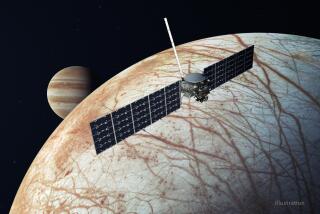Galileo Images Suggest Europa Could Meet Criteria for Life
- Share via
New images of Jupiter’s frozen moon Europa, released Friday by the Jet Propulsion Laboratory, reveal a barren, blasted landscape scarred by flows from ice volcanoes and torn by grinding tectonic plates.
The unusually detailed images of Jupiter’s largest and closest moon were taken by the space probe Galileo when it flew within 430 miles of the moon’s surface last month, more than 200 times closer than the Voyager 2 spacecraft did in 1979.
“This is the first time we have seen ice flows on the Jovian [bodies]; in fact, perhaps on any planetary surface in the outer solar system,” said Ronald Greeley, a member of the Galileo imaging team from Arizona State University.
The images appear to bolster the possibility that Europa’s icy surface harbors a potential haven for the development of life, researchers said, because the ice flows are evidence that the moon’s interior can generate enough heat to melt ice and release water.
Some scientists suspect that Europa’s forbidding surface may mask a large underground ocean heated by volcanic vents. If so, conditions around the vents might be favorable for the chemistry of life. On Earth, such deep-sea vents on the ocean floor are fertile spawning grounds for exotic forms of life.
“These new images demonstrate that there was enough heat to drive the flows on the surface. Europa thus has a high potential to meet the criteria” for the development of life, Greeley said. “It is a far stretch from being definitive. We don’t know the timing [of the ice flows] and we don’t know how extensive this upwelling may be. This is a small sampling of the planet.”
The images also show that the age of Europa’s surface varies dramatically. Some areas appear to be relatively young, with few craters, while other areas are pocked with large craters and pits.
So far, the probe has transmitted only one-third of the images it took of Europa. It will transmit the remainder starting Jan. 27.
The spacecraft will make a second pass by Europa on Feb. 20.






